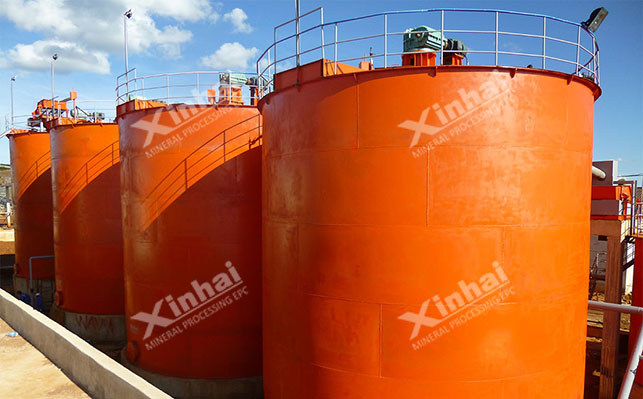
15311826613
Click to add WeChatGold ore leaching technology is a method of using a specific chemical solvent to fully contact the gold ore, dissolving the gold from the ore into the solution, and then extracting the gold from the solution through further processing. Its advantages are that it can process low-grade gold ores and complex and difficult-to-select gold ores, and has a wide range of applicability; it can achieve efficient recovery of gold and improve resource utilization; compared with traditional mineral processing methods, it can simplify the process flow and reduce costs to a certain extent; and under certain conditions, it can achieve in-situ leaching, reduce ore mining and transportation costs, and cause relatively little damage to the environment.
Currently, common gold ore leaching technologies include hydrogenation leaching technology and non-cyanide leaching technology. Let's learn about them together!
Cyanide leaching is an electrochemical process, which is a multiphase reaction method between oxygen-containing cyanide solution and solid gold particles. This method has simple process and low investment, and can effectively extract gold from gold ore, concentrate and tailings. In the cyanidation process. The dissolution of gold in cyanide is mainly divided into two stages. The first stage is that hydrogen peroxide is produced while gold is dissolved; the second stage is that the produced hydrogen peroxide cooperates with cyanide to dissolve gold again.

Non-cyanidation leaching methods include thiourea, halogenation, polysulfide, sea wave method and amalgamation method.
Thiourea method:Thiourea leaching gold must be carried out under acidic conditions. Thiourea (H2NCSNH2) aqueous solution is neutral and is an organic compound that is easily soluble in water. When the solution is acidic, thiourea can be reduced to various products such as dioxoguanidine. Gold and thiourea form soluble complex ions to extract gold. This is a complex liquid-solid phase reaction system composed of multiphase reactions such as adsorption, diffusion and mass transfer. The adsorption rate of this method is very fast, and the gold association is also particularly fast. Ultrasonic waves are used to strengthen the external force of diffusion, so that it is inhibited during the diffusion process, which can increase the leaching rate. The gold dissolution rate of thiourea leaching is four to five times that of cyanide leaching, which can avoid the situation of multi-film passivation. Its selectivity is relatively good, and its sensitivity to copper, zinc, arsenic and lead is much lower than that of cyanide. The disadvantage of this method is that thiourea is relatively expensive. Relatively speaking, the cyanide method is relatively cheap, and the thiourea method is suitable for acidic conditions and is not suitable for treating ores containing a large amount of alkaline gangue.
Iodination method: Gold can be completely oxidized in the presence of a complexing agent. This is because the simultaneous presence of an oxidant and a complexing agent is a necessary condition for gold dissolution. Iodine is a non-toxic agent. Iodine-oxidizing properties are second only to CN-. Gold enters the solution in the form of anionic complexes (AuI2)-. Iodine extracts gold from the gold-containing iodide solution. In the process of iodine-iodide solution leaching gold, the iodine leaching speed is more than ten times faster than that of cyanide. The iodination method is usually carried out in a weakly alkaline medium. Although the price of iodine is relatively expensive, it has little pollution to the environment. The iodination method is a very promising gold leaching technology.
Polysulfide method: The effective component in the polysulfide solution is polysulfide ions (Na2Sx, (NH4)2Sx solution), but the solution is relatively unstable, and the EDTA volumetric method is required to determine the concentration of polysulfide ions to determine the effective gold leaching component. This process is selective and basically pollution-free, and is mostly used to treat low-grade gold ores.
Hypo method: Also known as the thiosulfate method, thiosulfate is an inorganic chemical reagent that can form a stable complex with gold and leach in an alkaline medium. This method has little corrosion to equipment, fast leaching speed, is insensitive to impurities, and thiosulfate is cheap. Compared with the cyanide method, it has more advantages in treating carbonaceous gold ores, copper-containing gold ores, and high-arsenic and high-sulfur gold ores.
Amalgamation method: is to make liquid mercury contact with gold to produce chemical reactions, generate three compounds of AU2Hg, AU3Hg and solid solutions of gold and mercury, and make mercury spread and diffuse on the surface of gold particles to form mercury paste to capture gold particles and separate them from minerals. This method is efficient and low-cost, suitable for processing natural gold particles, but it has great environmental pollution and has been replaced by other methods.
The above is an introduction to gold ore leaching methods. In actual ore dressing plants, how to choose gold ore depends on the characteristics of gold ore. For single ore properties, gravity separation is generally used. For gold-containing fine or complex types, flotation can be used. For difficult types, cyanidation is often used for selection.